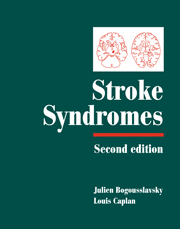Book contents
- Frontmatter
- Contents
- List of contributors
- Preface
- PART I CLINICAL MANIFESTATIONS
- 1 Stroke onset and courses
- 2 Clinical types of transient ischemic attacks
- 3 Hemiparesis and other types of motor weakness
- 4 Sensory abnormality
- 5 Cerebellar ataxia
- 6 Headache: stroke symptoms and signs
- 7 Eye movement abnormalities
- 8 Cerebral visual dysfunction
- 9 Visual symptoms (eye)
- 10 Vestibular syndromes and vertigo
- 11 Auditory disorders in stroke
- 12 Abnormal movements
- 13 Seizures and stroke
- 14 Disturbances of consciousness and sleep–wake functions
- 15 Aphasia and stroke
- 16 Agitation and delirium
- 17 Frontal lobe stroke syndromes
- 18 Memory loss
- 19 Neurobehavioural aspects of deep hemisphere stroke
- 20 Right hemisphere syndromes
- 21 Poststroke dementia
- 22 Disorders of mood behaviour
- 23 Agnosias, apraxias and callosal disconnection syndromes
- 24 Muscle, peripheral nerve and autonomic changes
- 25 Dysarthria
- 26 Dysphagia and aspiration syndromes
- 27 Respiratory dysfunction
- 28 Clinical aspects and correlates of stroke recovery
- PART II VASCULAR TOPOGRAPHIC SYNDROMES
- Index
- Plate section
5 - Cerebellar ataxia
from PART I - CLINICAL MANIFESTATIONS
Published online by Cambridge University Press: 17 May 2010
- Frontmatter
- Contents
- List of contributors
- Preface
- PART I CLINICAL MANIFESTATIONS
- 1 Stroke onset and courses
- 2 Clinical types of transient ischemic attacks
- 3 Hemiparesis and other types of motor weakness
- 4 Sensory abnormality
- 5 Cerebellar ataxia
- 6 Headache: stroke symptoms and signs
- 7 Eye movement abnormalities
- 8 Cerebral visual dysfunction
- 9 Visual symptoms (eye)
- 10 Vestibular syndromes and vertigo
- 11 Auditory disorders in stroke
- 12 Abnormal movements
- 13 Seizures and stroke
- 14 Disturbances of consciousness and sleep–wake functions
- 15 Aphasia and stroke
- 16 Agitation and delirium
- 17 Frontal lobe stroke syndromes
- 18 Memory loss
- 19 Neurobehavioural aspects of deep hemisphere stroke
- 20 Right hemisphere syndromes
- 21 Poststroke dementia
- 22 Disorders of mood behaviour
- 23 Agnosias, apraxias and callosal disconnection syndromes
- 24 Muscle, peripheral nerve and autonomic changes
- 25 Dysarthria
- 26 Dysphagia and aspiration syndromes
- 27 Respiratory dysfunction
- 28 Clinical aspects and correlates of stroke recovery
- PART II VASCULAR TOPOGRAPHIC SYNDROMES
- Index
- Plate section
Summary
Introduction
Definitions
The term ‘ataxia’ (Greek, a- (= negative article) + taxi (= order), (‘lack of order’) is commonly used synonymously with incoordination (Dow & Moruzzi, 1958; Gilman et al., 1981; Timmann & Diener, 1998). Ataxia is the most important sign of cerebellar disease. Cerebellar ataxia is defined as lack of accuracy or coordination of movement which is not due to paresis, alteration in tone, loss of postural sense or the presence of involuntary movements (DeJong, 1979). Cerebellar ataxia relates to motor dysfunctions of the limbs, trunk, eyes, and bulbar musculature. Ataxia of gait refers to incoordination of walking, which might be so severe that the patient cannot walk (abasia). Postural ataxia refers to ataxia of stance and sitting and includes truncal ataxia.The patient may be unable to sit or stand without support (astasia). Limb ataxia refers to incoordination of limb movements and ataxia of speech to cerebellar dysarthia.
Cerebellar disease results in postural and limb tremor. There may be a rhythmic tremor of the body that can evolve into a severe titubation. Limb tremor occurs as a kinetic and to a lesser extent static tremor. Kinetic tremor occurs as an oscillatory movement when the subject initiates a movement of the limb or during the course of moving the limb. The tremor becomes more prominent as the moving limb approaches a target (intention tremor). Powerful, but brief involuntary movements at the beginning of the movement are due to intention myoclonus, not tremor, and occur in diseases involving the dentate nucleus or the superior cerebellar peduncle.
Neurological findings in cerebellar disease
Patients with cerebellar disorders walk with a wide-based, staggering gait, making it seem as if they were intoxicated by alcohol.
- Type
- Chapter
- Information
- Stroke Syndromes , pp. 48 - 59Publisher: Cambridge University PressPrint publication year: 2001
- 3
- Cited by



